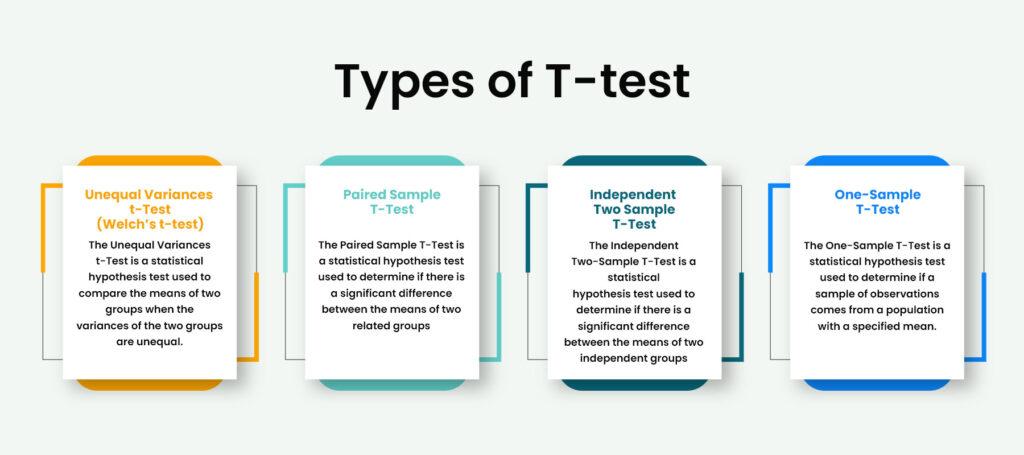Introduction to T-test
The T-test is a Statistical Hypothesis Test used to determine whether there is a significant difference between the means of two groups. It is a commonly used test in many fields, including psychology, education, and biology, to compare the means of two samples and to make inferences about the population means.
The t-test is based on the t-statistic, calculated as the difference between the sample means divided by the standard error of the difference. The t-statistic follows a t-distribution, which considers the sample size and the degree of variability in the data. The t-distribution has a bell-shaped curve, with most values falling close to zero. The t-statistic is used to determine the p-value, which is the probability of observing a difference as large or larger than the one observed in the sample, assuming that the null hypothesis is true.
A t-test is a powerful tool for comparing the means of two groups, but it has some limitations. One limitation is that it assumes that the data is normally distributed and that the sample size is large enough. Another limitation is that it can only be used to compare the means of two groups and to compare up to two groups.
To perform a t-test, the first step is to state the null and alternative hypotheses. The null hypothesis is the assumption that there is no difference between the means of the two groups. The alternative hypothesis is the assumption that there is a difference between the means of the two groups.
Next, the sample data must be collected and organized. The sample size should be large enough to ensure that the results are accurate and reliable. The sample means and standard deviations must be calculated for each group.
Once the sample data has been collected and organized, the t-statistic can be calculated. The t-statistic is calculated by subtracting the mean of the first group from the mean of the second group and dividing the result by the standard error of the difference. The standard error of the difference is calculated by taking the square root of the sum of the variances of the two groups divided by the sample size.
The p-value is then calculated using the t-statistic, and the degrees of freedom equal the total number of observations minus the number of groups being compared. The p-value is the probability of observing a difference as large or larger than the one observed in the sample, assuming that the null hypothesis is true.
The final step is to interpret the results of the t-test. Suppose the p-value is less than the significance level (usually set at 0.05). In that case, the null hypothesis is rejected, and it is concluded that there is a significant difference between the means of the two groups. Suppose the p-value is greater than the significance level. In that case, the null hypothesis is not rejected, and it is concluded that there is not enough evidence to support the claim that there is a significant difference between the means of the two groups.
You May Also Like to Read About : A quick guide on P Value
T-test Formula
The t test is a statistical method for determining the significance of the difference between the means of two groups. It calculates the ratio of the difference between the means of the two groups over the pooled standard error of both groups.
The formula for the T-test is given by:
t = (mean1 - mean2) / (sqrt((s1^2 / n1) + (s2^2 / n2)))In this formula, t is the t value, mean1 and mean2 are the means of the two groups being compared, s1 and s2 are the standard deviations of the two groups, and n1 and n2 are the number of observations in each group.
A larger t value indicates that the difference between the means of the two groups is greater than the pooled standard error, which suggests a statistically significant difference between the groups. This result can be compared to critical values in a t-distribution table to determine if the difference between the groups is statistically significant. If the calculated t value is greater than the critical value, the null hypothesis that the groups are equal can be rejected, and it can be concluded that the two groups are indeed different.
Types of T-test

Here are some different types of T-tests and their implementation in Python and R:
- One-Sample T-test
- Independent Two-Sample T-Test
- Paired Sample T-Test
- Unequal Variances t-Test (Welch’s t-test)
One-Sample T-Test
The One-Sample T-Test is a statistical hypothesis test used to determine if a sample of observations comes from a population with a specified mean. The test assumes that the sample is randomly selected from a normally distributed population and that the population’s standard deviation is unknown. The goal of the test is to determine if the sample’s mean is significantly different from a specified value (known as the hypothesized mean) or if it is similar enough that the difference could have occurred by chance.
With Python:
import scipy.stats as stats
import numpy as np
np.random.seed(10)
sample = np.random.normal(loc=50, scale=10, size=100)
t_statistic, p_value = stats.ttest_1samp(sample, 55)
print(f"T-Statistic: {t_statistic}, P-Value: {p_value}")With R:
library(stats)
set.seed(10)
sample <- rnorm(100, mean = 50, sd = 10)
t_test <- t.test(sample, mu = 55)
t_statistic <- t_test$statistic
p_value <- t_test$p.value
cat("T-Statistic:", t_statistic, "P-Value:", p_value)Independent Two-Sample T-Test
The Independent Two-Sample T-Test is a statistical hypothesis test used to determine if there is a significant difference between the means of two independent groups. The test assumes that the two groups are independent, have equal variances, and are normally distributed. It compares the means of two groups when the observations within each group are independent and identically distributed.
With Python:
import scipy.stats as stats
import numpy as np
np.random.seed(10)
sample1 = np.random.normal(loc=50, scale=10, size=100)
sample2 = np.random.normal(loc=45, scale=10, size=100)
t_statistic, p_value = stats.ttest_ind(sample1, sample2)
print(f"T-Statistic: {t_statistic}, P-Value: {p_value}")With R
library(stats)
set.seed(10)
sample1 <- rnorm(100, mean = 50, sd = 10)
sample2 <- rnorm(100, mean = 45, sd = 10)
t_test <- t.test(sample1, sample2)
t_statistic <- t_test$statistic
p_value <- t_test$p.value
cat("T-Statistic:", t_statistic, "P-Value:", p_value)Paired Sample T-Test
The Paired Sample T-Test is a statistical hypothesis test used to determine if there is a significant difference between the means of two related groups. The test compares the means of two groups when the observations within each group are related or matched in some way. For example, the test could be used to compare the heights of individuals before and after a treatment or to compare the test scores of students before and after a study intervention.
With Python
import scipy.stats as stats
import numpy as np
np.random.seed(10)
before = np.random.normal(loc=50, scale=10, size=100)
after = before + np.random.normal(loc=5, scale=5, size=100)
t_statistic, p_value = stats.ttest_rel(before, after)
print(f"T-Statistic: {t_statistic}, P-Value: {p_value}")With R
library(stats)
set.seed(10)
before <- rnorm(100, mean = 50, sd = 10)
after <- before + rnorm(100, mean = 5, sd = 5)
t_test <- t.test(before, after, paired = TRUE)
t_statistic <- t_test$statistic
p_value <- t_testUnequal Variances t-Test (Welch’s t-test)
The Unequal Variances t-Test is a statistical hypothesis test used to compare the means of two groups when the variances of the two groups are unequal. This test is also known as Welch’s t-test. The test statistic is calculated differently from the traditional t-test, considering the unequal variances. The Unequal Variances t-Test is useful in cases where the assumption of equal variances between two groups is not met.
With Python
import scipy.stats as stats
import numpy as np
group1 = [2, 4, 6, 8, 10]
group2 = [1, 3, 5, 7, 9, 11]
t_statistic, p_value = stats.ttest_ind(group1, group2, equal_var = False)
print("T-Statistic: ", t_statistic)
print("P-Value: ", p_value)
With R
group1 <- c(2, 4, 6, 8, 10)
group2 <- c(1, 3, 5, 7, 9, 11)
t.test(group1, group2, var.equal = FALSE)
Interpretation of Scripts (Python & R)
When interpreting the results of t-tests in Python or R, it is important to look at two key values: the t-statistic and the p-value.
The t-statistic measures the difference between the means of the two groups in units of standard error. A large t-statistic indicates a large difference between the means of the two groups.
The p-value is the probability of observing a t-statistic as extreme or more extreme than the one calculated, assuming the null hypothesis is true. A small p-value (generally less than 0.05) indicates strong evidence against the null hypothesis, while a large p-value (greater than 0.05) indicates weak evidence against the null hypothesis.
Here’s an example of how to interpret the results of a one-sample t-test in Python using the scipy library:
import scipy.stats as stats
# Calculate the t-test for the mean of a single sample
t_statistic, p_value = stats.ttest_1samp(data, popmean)
# Interpret the results
if p_value < 0.05:
print("The mean of the sample is significantly different from the population mean (p = {})".format(p_value))
else:
print("The mean of the sample is not significantly different from the population mean (p = {})".format(p_value))
Here’s an example of how to interpret the results of an independent samples t-test in Python using the scipy library:
import scipy.stats as stats
# Calculate the t-test for the means of two independent samples
t_statistic, p_value = stats.ttest_ind(sample1, sample2)
# Interpret the results
if p_value < 0.05:
print("The means of the two samples are significantly different (p = {})".format(p_value))
else:
print("The means of the two samples are not significantly different (p = {})".format(p_value))
Here’s an example of how to interpret the results of a dependent samples t-test in R using the stats library:
library(stats)
# Calculate the t-test for the means of two dependent samples
t_test_result <- t.test(sample1, sample2, paired = TRUE)
# Extract the t-statistic and p-value
t_statistic <- t_test_result$statistic
p_value <- t_test_result$p.value
# Interpret the results
if (p_value < 0.05) {
cat("The means of the two samples are significantly different (p =", p_value, ")\n")
} else {
cat("The means of the two samples are not significantly different (p =", p_value, ")\n")
}
Inferences of T- Test with above Python & R Scripts
In regards to the t-test and the scripts mentioned above, the main inference one can draw is about the difference between the means of two groups. The t-test helps to determine if this difference is statistically significant, meaning it is unlikely to have occurred by chance.
When interpreting the results of the t-test, one must look at the t-statistic and the p-value. The t-statistic measures the difference between the means of the two groups in units of standard error. A large t-statistic indicates a large difference between the means of the two groups. The p-value is the probability of observing a t-statistic as extreme or more extreme than the one calculated, under the assumption that the null hypothesis is true.
A p-value less than 0.05 is considered significant and indicates strong evidence against the null hypothesis, which assumes that there is no difference between the means of the two groups. On the other hand, a p-value greater than 0.05 indicates weak evidence against the null hypothesis and suggests that the difference between the means of the two groups may not be statistically significant.
It is important to note that the t-test is just one tool for comparing the means of two groups and should be used in conjunction with other methods, such as visual inspection of the data and effect size measures, to gain a full understanding of the results.
Conclusion
The scripts mentioned above provide a way to calculate and interpret the results of t-tests in Python and R. They can be used to determine the significance of the difference between the means of two groups, which can inform further analysis and decision making.



Great information
Well explained:)
Great and informative post !!
Quite useful and informative blog
Insightful article 👍🏻 helped me boost my knowledge
As always, loved the content of Brainalyst. This was indeed a comprehensive piece from the team.
Good content and well explained
Brainanalyst always provides value-adding content
Informative